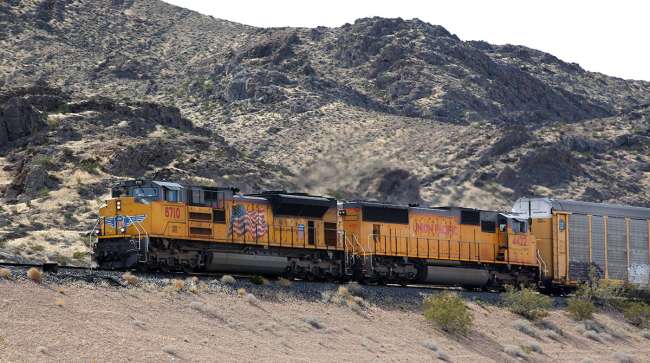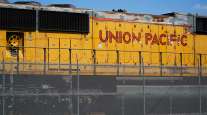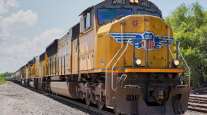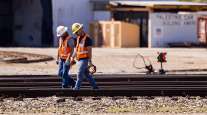Senior Reporter
Union Pacific Reports Strong Q2 Earnings

[Stay on top of transportation news: Get TTNews in your inbox.]
Omaha, Neb.-based Union Pacific Corp. reported strong second-quarter results, surpassing expectations of Wall Street analysts.
The Class I railroad said July 22 that net income was $1.78 billion, or $2.73 per share, compared with $1.13 billion, $1.67 per share, in last year’s second quarter.
The average estimate of six analysts surveyed by Zacks Investment Research called for earnings of $2.55 a share.
Union Pacific ( $UNP ) Reports Second Quarter 2021 Results.
Today, UP reported 2021 second quarter net income of $1.8 billion, or $2.72 per diluted share. https://t.co/RGt6MEi1Ji — Union Pacific (@UnionPacific) July 22, 2021
Union Pacific posted revenue was up 29% year-over-year to $5.13 billion, compared with $3.97 billion a year ago.
“The Union Pacific team leveraged volume growth, core pricing gains and productivity to produce record quarterly results,” CEO Lance Fritz said. “These strong results were achieved in a challenging environment as our rail network continues to be impacted by supply chain disruptions, particularly in the intermodal space. As we move into the second half of 2021, we will continue working with our customers and the broader supply chain to increase fluidity and efficiently handle the strong demand for freight transportation.”
While other railroads, including CSX Corp., are saying they are having difficulty hiring enough employees, UP officials said they’re managing the ongoing labor shortage that impacts not only the railroads but also the trucking industry.
UP’s leadership believes it can handle rising freight volumes and hire enough employees to keep operating smoothly.
“Right now, we’re really not seeing substantial problems hiring labor,” Fritz said. “We’re not yet in a place where we think it is an impediment. But longer term, we have to make our jobs more attractive to attract a really big pool to our jobs.”
The labor shortage issue is getting the attention of shippers. The American Chemistry Council, whose members include industry giants including Honeywell International Inc. and Dow Inc., has written to the Surface Transportation Board indicating their concern with delays in the nation’s rail network. While not explicitly mentioning UP, the American Chemistry Council said in its letter that across the rail industry, some railcars have waited in yards for more than a week, and travel times on some critical routes have doubled, causing some factories to close or reduce production.
ACC Letter by Transport Topics
“Current rail service challenges are harming ACC member companies, disrupting supply chains, restricting manufacturing, increasing costs, and preventing companies from meeting customer expectations,” the letter said.
UP said its operating ratio improved to an all-time 55.1 compared with 61.0 last spring.
Operating ratio, or operating expenses as a percentage of revenue, is used to measure efficiency. The lower the ratio, the higher the company’s ability to generate profit.
Union Pacific is one of several freight railroads that has embraced precision scheduled railroading to improve its efficiency. With PSR, longer trains are managed and operated by fewer employees.
The average freight train length increased 9% to 9,410 feet or 1.78 miles, compared with 8,664 feet or 1.64 miles in 2020.
“We will continue to focus on train length to run a more efficient and reliable railroad for our customers,” Eric Gehringer, executive vice president of operations, said on a conference call with analysts after the financial report was announced.
The average distance traveled by trains declined 6% to 213 miles per day, compared with 227 miles per day in 2020.
However, UP officials said the decision in 2019 to retire dozens of older, less efficient locomotives and park them at rail yards, including in Topeka, Kansas, resulted in a significant reduction in diesel use.

Fritz
“Beyond our strong financial performance, we also made progress on our goal to reduce our carbon footprint, which includes a 3% improvement in our fuel consumption rate,” said Fritz.
The railroad said it has more than a dozen initiatives in place to reduce its overall fuel consumption.
Revenue increased in all but one of the sectors that the UP carries freight.
Grain and grain products increased 3.8% to $795 million from $766 million.
Fertilizer shipments rose 5.3% to $179 million from $170 million.
Food and refrigerated product shipments saw a 6.8% improvement to $251 million from $235 million.
Coal and renewable energy products rose 24% to $423 million from $341 million.
Bulk products notched upward 8.6% to $1.64 billion from $1.51 billion.
Metals and minerals saw a 24.5% increase to $467 million from $375 million.
Forest products were up 10.1% to $348 million from $316 million.
Energy and specialized markets revenue increased 3% to $546 million from $530 million.
Industrial product shipments moved up 12.1% to $1.85 billion from $1.65 billion.
Intermodal shipments increased 15.5% to $1.19 billion from $1.03 billion.
Premium cargo showed a 20.4% increase to $1.62 billion from $1.48 billion.
Automotive shipments were the only area to report a decline, dropping 4.7% to $428 million compared with $447 million.
Want more news? Listen to today's daily briefing below or go here for more info:




